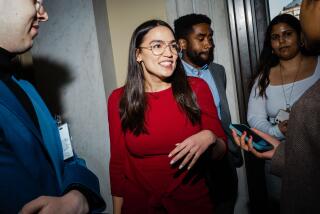Shevardnadze to Begin Trip to South America : 3-Nation Mission, Aimed at Forging Closer Ties, Signals Soviets’ New Approach, Diplomats Say
- Share via
BRASILIA, Brazil — Foreign Minister Eduard A. Shevardnadze arrives in Brazil today on a three-nation mission aimed at strengthening the Soviet Union’s ties with South America.
Shevardnadze is the highest Soviet official ever to visit Brazil, South America’s largest nation. From here he will go to Argentina, the continent’s second-largest country, and then to neighboring Uruguay.
Some analysts say the diplomatic overture stems from Soviet leader Mikhail S. Gorbachev’s glasnost policy.
“We see the trip by Minister Shevardnadze as part of that new Soviet policy of opening up,” said an influential Brazilian official. He said the trend in Soviet foreign policy appears to be toward expanded and “de-ideologized” relations with non-Communist governments.
‘New Approach’
A Western diplomat based in Brasilia agreed that Shevardnadze’s South American trip signals a new Soviet approach.
“It is a new approach for Latin America, just as it is for the United States or Western Europe,” the diplomat said.
Another foreign diplomat said Brazilian authorities also are interested in closer relations with the Soviet Union. “They are a country that is significant and they want to deal with other significant countries,” he said.
Roberto Abreu Sodre, Brazil’s foreign minister, said in an interview published here Sunday that Shevardnadze’s visit “opens a new and important phase in the bilateral relations” of Brasilia and Moscow. Sodre added that the two countries are strengthening their relations “within a perfectly clear context in which Brazil and the U.S.S.R. have differentiated international responsibilities and positions.”
Shevardnadze, who has been attending the U.N. General Assembly in New York, is scheduled to arrive in the Amazon jungle city of Manaus this afternoon, flying on to Rio de Janeiro in the evening. He is to spend Sunday resting in Rio before coming to Brasilia on Monday for official talks.
He will fly to Argentina on Wednesday afternoon and then to Uruguay on Oct. 5.
Shevardnadze’s main concerns on the trip are expected to include problems in trade with both Brazil and Argentina.
According to Brazil’s Central Bank, the total value of Brazilian-Soviet trade dropped in 1986 to $310 million from a high of $833 million in 1983. The two countries’ trade balance has been overwhelmingly in favor of Brazil.
Trade between the Soviet Union and Argentina has dropped even more dramatically, to $267 million in 1986 from $1.66 billion in 1983.
Long-Term Agreement
Soviet grain purchases from Argentina soared at the beginning of the 1980s after the Jimmy Carter Administration imposed a boycott on U.S. grain sales to Moscow. But the Argentine sales plummeted last year as renewed U.S. sales increased.
Soviet exports to Argentina have been virtually insignificant, inching up from $31 million in 1983 to $59 million in 1986.
As a whole, South America accounts for less than 1% of total Soviet exports.
Shevardnadze is scheduled to sign an agreement with Brazil for long-term economic, scientific and technological cooperation.
“That agreement has to open up prospects for economic cooperation and trade,” said Vitaly M. Mouzankov, a spokesman for the Soviet Embassy in Brasilia.
Mouzankov said the Soviet Union is especially interested in Brazil, noting that this country has the West’s eighth-largest economy. He said Soviet relations with Brazil “are developing rapidly, not only in the economic but the political sphere.”
How strong those relations become will depend to a great extent on increased trade and investment, said one Brazilian diplomat. He said Brazil wants “concrete demonstrations” by the Soviets that they are willing to open their market to Brazilian products and provide needed technology for Brazilian development projects.
Gorbachev and Brazilian President Jose Sarney have exchanged invitations for state visits, but no dates have been set.
“Everything depends on relations acquiring a greater density that would justify a visit,” the Brazilian diplomat said in a background interview.
‘Opening Paths’
In a separate interview, a spokesman for the Brazilian Foreign Ministry said Shevardnadze’s visit is intended to explore ways of strengthening relations between the two countries.
“It is a visit for opening paths, for getting to know each other better,” said the spokesman. “There is a political will for moving closer.”
But a foreign diplomat predicted that Shevardnadze’s visit will not result in a dramatic upgrading of Brazilian-Soviet relations.
“It would just set off too many alarm bells, internally and externally,” he said.
Brazil’s diplomatic relations with the Soviet Union were established in 1962 by then-President Joao Goulart, a left-leaning Populist who was overthrown by a military coup in 1964.
The military government maintained discreetly cool diplomatic ties with Moscow until the armed forces relinquished power in March, 1985.
Olavo Setubal, Sarney’s first foreign minister, was the first Brazilian foreign minister to visit the Soviet Union. During 1986, two other Cabinet ministers, a state governor, a congressional delegation and 15 trade missions from Brazil visited the Soviet Union.
Argentina’s emergence from right-wing military rule in 1983 and Uruguay’s in 1985 also set the stage for improvements in their relations with Moscow. Last October, Raul Alfonsin became the first Argentine president to visit the Soviet Union.
During that visit, Soviet authorities renewed a commitment for large grain purchases from Argentina during the next four years. But in the first quarter of 1987, Argentine sales to the Soviets totaled less than $150 million.
Argentina was one of only three Latin American countries that maintained diplomatic relations with the Soviet Union before Fidel Castro’s 1959 revolution in Cuba. The others were Mexico and Uruguay. Moscow now has embassies in 15 Latin American and Caribbean capitals.
More to Read
Sign up for Essential California
The most important California stories and recommendations in your inbox every morning.
You may occasionally receive promotional content from the Los Angeles Times.










